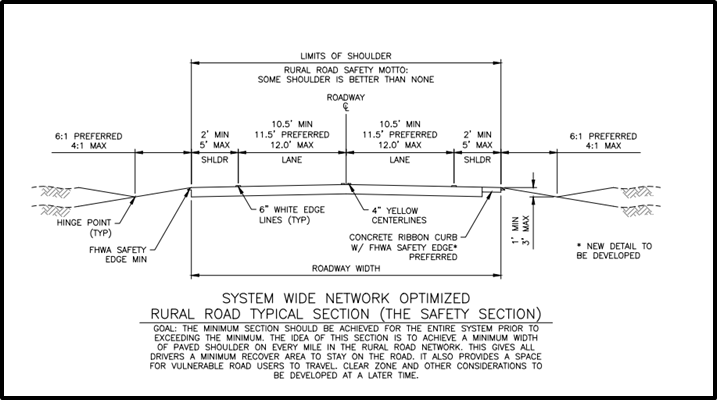The Rural Road Safety Typical Section Initiative
Written by Seth Chalmers, PE

Background on Rural Road Crashes
Rural road safety is a key issue in traffic engineering. According to the 2017 Traffic Safety Facts publication, which is compiled and published by the U.S. Department of Transportation’s (USDOT) National Highway Traffic Safety Administration (NHTSA), there were 34,247 fatal motor vehicle traffic crashes in the U.S. that resulted in 37,133 fatalities. Of these fatal crashes, 17,216 (45%) occurred in rural areas. Of these rural road fatal crashes, over a third were the result of lane and road departures. In light of these statistics, rural road safety initiatives need to focus on mitigating this type of crash.
In terms of the crash type, lane and road departure crashes are more of a “road type” rather than a “location type.” In other words, rural road crashes happen because the nation’s network of rural roads often lacks features that help prevent crashes. However, rural roads are not lacking when it comes to having features that increase the likelihood and severity of crashes. A major cause of these crashes is a lack of investment in safety improvements, which has been further exacerbated by the lack of priority in addressing lane and road departure crashes.

Rural Road Safety Issues
While achieving a “safer” rural road may seem like a daunting task, the solution to safer rural roads is actually not that complex. What is needed, first and foremost, is a road section that is better at keeping drivers on the road and in their lane. Additionally, if they go off the road, the roadside needs to be forgiving as possible, allowing them to ride out their road departure, regain control of their vehicle, and come to a safe stop without overturning or running into something.
Many rural road users have a tendency of driving too fast, even though the road is unsuitable for high speeds, which increases the severity of crashes when they do happen. Increased speeds also contribute to crashes on curves, corners, and intersections with other roads or driveways. When drivers are “surprised” by an unexpected situation, they are often driving too fast to avoid it or stop in time. They may hit something, go off the road, or roll over, often with dire consequences.
Paved rural roads with higher speed limits (35+ mph) that do not have paved safety shoulders and/or dedicated left-turn lanes at road intersections are not safe for ordinary travel and use – they are defective and lead to crashes. Something needs to be done about roads like this as soon as possible.

Solutions to Increase Safety
So, what do rural roads need to be safer? More investment in countermeasures that significantly improve the safety performance of the roadway would be a good start. These could include:
- Guardrails
- Paved safety shoulders with a minimum width of 2 feet, whenever possible
- Travel lanes with a minimum width of 10.5 feet
- Dedicated turn lanes (or enough paved roadway width) to allow vehicles to drive around vehicles waiting to turn
- Forgiving road edges and sides
- Pavement markings
- Enhanced warnings, delineation, and friction surfaces on curves with a higher risk or known history of crashes
Countermeasures such as these are proven to reduce crashes, especially those resulting in serious injuries and fatalities. When it comes to lane widths and especially paved safety shoulders, wider is always more desirable; however, agencies need to be pragmatic with what is affordable and pursue whatever safety improvements they can.

Approach to Implementing Solutions
In an ideal world, we would be able to improve as many miles as possible along rural roads, addressing the key issues that contribute to lane and road departure crashes. However, due to lack of funding, we often must focus on the improvements that provide the highest benefits at the lowest costs and with the fewest complications – rather than a full “standard” improvement. Even these smaller improvements can meet the goal of achieving an adequate level of safety performance on more miles of roadway.
For example, some paved safety shoulder is better than no paved shoulder. Combining some amount of paved safety shoulders with well-delineated wider lanes provides drivers with more room, thus enhancing their ability to stay in their lane and on the road. This little bit of extra room gives drivers an area to recover from an error that might otherwise lead to a lane or road departure crash. This extra room also provides some space for other non-vehicle road users such as pedestrians and bicyclists – who are sometimes called vulnerable road users (VRUs) – to use these roads.
In terms of safety performance, three miles of rural road with at least 2 feet of paved safety shoulder and a minimum lane width of 10.5 feet will provide a better level of safety performance than one mile of rural road with 6-foot paved safety shoulders and 12-foot lanes, which is the fully improved rural road “standard.”
There are numerous obstacles to adding extra space along our nation’s network of rural roads. Unfortunately, agencies often postpone any improvements until they can achieve a fully improved rural road section due to “perceived” liability risk. Pavement rehabilitation often only repaves the road as is, rather than also widening lanes or shoulders, providing shoulders, or adding dedicated turn lanes. The majority of funding, like the Surface Transportation Block Grant Program (STBGP), goes to building new roads or adding capacity to existing roads in urban areas. And funding that does support rural road improvements, such as the Highway Safety Improvement Program (HSIP) or a much under-funded rural road safety set-aside of some sort, does not typically prioritize systematically addressing lane and road departure crashes by providing minimum-width lanes and safety shoulders.

Next Steps Toward a Rural Road Safety Typical Section
With the recent passage of the Infrastructure Investment and Jobs Act (IIJA), the Federal Highway Administration (FHWA) could set a national goal that all 50 states, Native nations, and federal lands should achieve as much rural road safety as possible, with a focus on preventing lane and road departure crashes. FHWA could set a minimum rural road safety section, as such as the one below, for states to achieve throughout their entire rural road network; this would include all rural roads regardless of jurisdiction. FHWA could also allow applicable federal funding sources to support implementation of this section, either as separate projects or as part of state/local pavement rehabilitation projects. FHWA could also make provisions to allow for expedited National Environmental Protection Act (NEPA) Category I Exclusions if the improvements took place within the existing roadway template.

Improving safety along our nation’s rural road network by mitigating lane and road departure crashes is a pressing issue. By requiring 2-foot minimum paved safety shoulders and 10.5-foot minimum lane widths on all rural roads – as well as leveraging IIJA funding to target rural road improvements – we can make significant progress in improving safety for rural road users.

